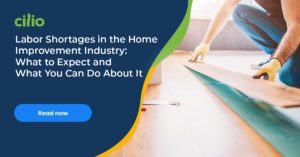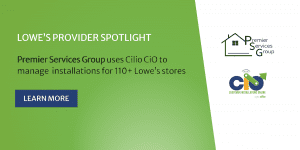On January 28th, 2025, Cilio sponsored a webinar titled “Home Improvement 2025: Challenges, Opportunities, and Solutions”. The webinar moderated by Gary White, included guest speaker Todd Tomalak (Zonda), plus a panel of industry experts that included Josh Blake (Premier Services Group) and Nick Simmons (Install Partners). Each offered real-world perspectives on labor and operational challenges.
This webinar offered invaluable insights into the challenges and opportunities facing the home improvement industry, with actionable takeaways for businesses to prepare for future growth. Below are just a handful of the insights shared.
Key Economic and Market Forecast for 2025
Todd compared the current economic conditions to the early 1980s when high interest rates suppressed remodeling activity, only to be followed by unprecedented growth once rates stabilized. He cautioned the industry to prepare for similar patterns.
- Slow Growth Forecast: Spending is projected to grow by 5.3% in 2025, with approximately 4% attributed to price increases rather than volume. The first half of the year is expected to remain soft due to high interest rates, depleted consumer savings, and price sensitivity.
- Cautionary Period: The combination of rising mortgage rates (over 7%) and economic challenges is making it difficult to raise prices, creating short-term pressure on the industry.
- Market conditions can change rapidly. While forecasts remain cautious for 2025, Todd urged companies to be prepared to pivot as deferred demand is unleashed when rates moderate, spurring a wave of growth in the later part of the year.
- Accelerated Growth: By the second half of 2025, growth is expected to accelerate, leading into what Todd described as a potential “Golden Age of Remodeling” in 2026-2027, with double-digit annual increases in remodeling activity.
- Deferred Projects Driving Demand: Many home improvement projects have been delayed due to economic constraints, particularly among middle-income households. Once conditions stabilize, this deferred demand is expected to create a surge in activity.
The Home Equity Factor: A Remodel Boom Waiting to Happen?
During the webinar, Todd Tomalak highlighted a critical financial trend that could signal a major shift in home improvement spending:
In the past 24 months, there have been more new net accounts added to access ‘Home Equity’ (HELOCs + Cash-Out) than in the previous 12 years combined. However, while homeowners are setting up these credit lines, they have not yet withdrawn the funds – suggesting a strong pent-up demand for home renovations that has yet to materialize. The moment homeowners start pulling funds from these accounts, the industry should expect a rapid increase in renovation activity.
- Many homeowners have been holding off on major renovation projects due to high interest rates, economic uncertainty, and inflation.
- Homeowners frustrated with their current living conditions (due to mortgage rate lock-in effects) may choose renovation over relocation, further boosting demand.
- Homeowners are likely waiting for interest rate stabilization before tapping into their home equity. If rates fall below 6%, this could trigger a wave of remodeling projects as homeowners unlock financing.
Contractors, manufacturers, and distributors should take this as a warning to prepare now, ensuring they have the labor, supply chain, and marketing strategies in place to capitalize on the next wave of demand.
Be prepared for a potential surge in mid-to-late 2025, especially if interest rates ease. Watch home equity withdrawal trends – they will signal when homeowners start investing in major projects. Focus on essential, non-discretionary work (HVAC, roofing, windows, water heaters) while waiting for big-ticket discretionary spending to return.
Remodeling Trends: What’s Driving Demand?
Many homeowners are stuck in homes they are dissatisfied with due to high interest rates and limited inventory. This “beach ball underwater” effect has created a backlog of remodeling projects.
- Bathrooms: The average U.S. bathroom is updated only every 40–50 years. To meet even this minimal replacement cycle, bathroom remodeling would need to increase by 25%. Higher-end homes may see faster cycles, while mid- to lower-income homes might delay upgrades much longer due to cost constraints.
- Windows and Doors: Homes over 20 years old with original windows and doors represent a massive pool of deferred projects. Todd noted that this pool is currently double the historical norm.
- Remodeling activity will increasingly overlap with other major PRO projects, such as patio upgrades and kitchen remodels, often fueled by home equity loans.
- Contractors should prioritize marketing to homeowners with aging homes, as demand will spike when economic conditions improve.
Labor Shortages: The Biggest Hurdle Ahead
Todd emphasized that from 2025 to 2030, professional installation labor will dominate the remodeling landscape. However, labor shortages continue to impact the industry. Businesses equipped to scale their labor resources will capture the most value.
- The industry is losing skilled labor at an alarming rate, with pro labor underpacing growth by at least –15% by 2030.
- Retirements, fewer young workers entering the trades, and a lack of training programs are compounding the issue.
- Companies that effectively attract, train, and retain skilled labor will have significant competitive advantages in the coming years.
- Investing in workforce development programs, such as partnerships with schools and apprenticeship opportunities. This includes engaging younger generations by promoting the value and opportunities within trade careers.
The Rise of E-Commerce in Home Improvement
The way contractors buy materials is changing fast. Online purchasing of building supplies has nearly doubled since 2019, with more pros turning to digital platforms for convenience and availability.
- Online purchases of building materials have nearly doubled since 2019, growing from 4.8% to 8.3% of the total market.
- Contractors increasingly rely on platforms like Home Depot and Lowe’s for both convenience and availability, even as supply chains normalize post-COVID.
- This mirrors trends in other industries, where online distribution has concentrated market power among top players.
- Not all manufacturers will succeed in passing on price increases to consumers due to rising tariffs and input costs. Pro contractors, empowered by e-commerce and increased market influence, will have significant pricing power in the coming years.
- Suppliers must adapt to online ordering trends, as pros continue shifting toward digital-first purchasing.
Final Thoughts: Preparing for the Future of Home Improvement
While the first half of 2025 may bring slow growth, the second half is shaping up to be a major turning point for the home improvement industry. With rising home equity, deferred remodeling projects, and potential interest rate relief, the stage is set for a surge in demand.
Contractors who prepare now – by strengthening their labor force, streamlining operations, and adapting to shifting consumer buying habits – will be in the best position to capitalize on the opportunities ahead.
Whether it’s staying ahead of labor shortages, embracing e-commerce, or focusing on high-demand services, industry professionals should take these insights as a call to action. The next wave of home improvement growth is coming – those who plan today will thrive tomorrow.




